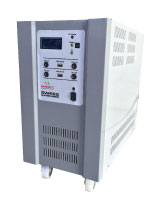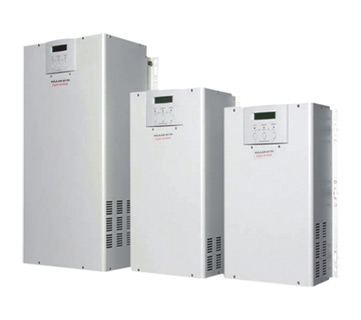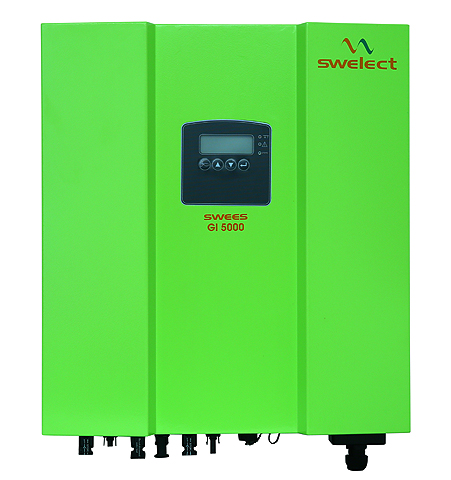Solar Inverters

Features:
- DC Priority to reduce utility / grid consumption
- Long back-up hours
- Pure Sine wave output
- No load disturbance during change over between mains and battery
- Good output voltage regulation in line-mode operation

| Models | SWEES SPG AI 500 | SWEES SPG AI 1000 |
| W | 500 | 1000 |
| Nominal Voltage(V) | 18 | 36 |
| Current(A) | 30 | 30 |

Features:
- Advanced Microprocessor based design
- Automatic Line to Battery switch over
- Intelligent Multistage charger (10-40A / 10-60A)
- High Efficiency DC – AC Conversion
- Overload protection
- Auto restart
- Separate part for Solar Power input
- Input & Output Isolated
- Auto bypass
- Compact design
- Compatible with SMF / Tubular Batteries
- Generator Compatibility

| Models | SWEES HPH SWS 12 12 | SWEES HPH SWS 24 24 | SWEES HPH SWS 36 24 | SWEES HPH SWS 50 24 | SWEES HPH SWS 60 48 | SWEES HPH SWS 80 48 |
| kVA | 1.2 | 2.4 | 3.6 | 5 | 6 | 8 |
| W | 800 | 1600 | 2400 | 4000 | 6000 | 8000 |
| VDC | 12 | 24 | 24 | 24 | 48 | 48 |
| Input / Output:1/1 | √ | √ | √ | √ | √ | √ |

Features:
- Multiple operation modes: Grid Tie, Stand-alone and Grid-Tie with back-up
- Micro processor controlled technology
- Output - Pure sine wave form
- Built-in MPPT solar charger
- Generator compatibility
- User friendly LCD Display
- Various communication options
- User adjustable charging current
- Self-consumption and Feed-in to the grid
- Programmable supply priority for PV, Battery or Grid
- Built-in timer for various mode of on/off operation
- Multiple communication for USB, RS-232, Modbus and SNMP
- Monitoring software for real-time status display and control

| Models | SWEES SPV HB 3000 | SWEES SPV HB 10000 |
| kVA | 3 | 10 |
| kW | 3 | 10 |
| Input / Output:1/1 | √ | |
| Input / Output:3/3 | √ |

Features:
- Transformerless Compact Design
- Advanced DSP Control Technology
- Upto 96% High Conversion Efficiency
- > 99.5% MPPT Efficiency
- Compact Size, Light Weight
- Plug & Play – ease of Installation
- 1-3 MPPT Tracker
- Single Phase / Three Phase
- LCD Display to monitor the parameters
- Communication interface options to monitor operational status and electricity generated data
- IP – 65 Cabinets suitable for Outdoor Applications
- Compliance to International Standards

| Models | GI 1Z1000 | GI 1Z1500 | GI 1Z2000 | GI 1Z3000 | GI 1Z4000 | GI 1Z5000 |
| VA | 1100 | 1750 | 2200 | 3000 | 4400 | 5000 |
| kW | 1 | 1.5 | 2 | 3 | 4 | 5 |
| Output:1/1 | √ | √ | √ | √ | √ | √ |
| Models | GI 3Z4000 | GI 3Z5000 | GI 3Z6000 | GI 3Z8000 | GI 3Z10000 | GI 3Z15000 | GI 3Z17000 | GI 3Z20000 | GI 3Z33000 |
| VA | 4400 | 5500 | 6000 | 8800 | 10000 | 16500 | 18700 | 20000 | 33000 |
| kW | 4 | 5 | 6 | 8 | 10 | 15 | 17 | 20 | 33 |
| Output:3/3 | √ | √ | √ | √ | √ | √ | √ | √ | √ |
GRID CONNECTED SOLAR POWER SYSTEMS
You can have solar energy powering your home, school, church, community building or business easily and economically by installing a mains electricity supply integrated grid connect rooftop system!
RESIDENTIAL SOLAR POWER SYSTEMS
Would you like to power your home using the sun’s free power? It may be easier and cheaper than you think to install solar panels! Seven Rays are the grid connect professionals, with hundred of residential installations successfully completed!
- Solar inverters, sometimes called PV inverters, are types of electrical inverters which are developed to change a DC (direct current) voltage from photovoltaic arrays into AC (alternating current) currents which in turn are used to power home appliances and some utility grids. These solar inverters are very popular nowadays as electricity costs continue to rise. Also, this helps conserve energy for future use. solar inverter converts it to 240V 50Hz AC electricity. The 240V AC electricity can be used to power home appliances
Functions of Solar Inverters
The engineering of these solar inverters and solar panels are designed like pieces of puzzles which should fit together in order to function. Conclusively, these solar inverters are programmed to hook up to a specific count of solar boards. The cost of inverter is practically 10 percent of the total cost of the solar board. We have to take note that these solar inverters do not have useful lives equally long as that of solar panels. This means you have to replace your solar inverters from time to time for you to use your solar system for its remaining useful life. For a solar inverter to work efficiently it should have adequate solar panels connected to it. Lesser or more panels that are connected to it could cause it not to function properly. Consequently, it should have at least 95 percent of panels hooked up to obtain optimum performance.
The Stand Alone Solar Inverter
These stand alone solar inverters are called such because they do not need to be hooked up into a solar panel. Instead, it draws its direct current (DC) power from batteries which are charged by photovoltaic (PV) arrays or other resources such as engine generators, hydro turbines and wind turbines. There are a lot of these stand alone inverters which integrate vital battery chargers to refill the battery coming from an alternating current (AC) source whenever possible. Because these inverters are isolated from utility grids, they do not require anti-islanding protection.
The Grid Tie Inverters
The grid tie inverters match the phase alongside a utility charged sine wave. These grid tie inverters are also programmed to automatically turn itself off during power losses to ensure safety. Hence, these inverters do not provide emergency power during these times. It is recommended for a home which is powered by a utility grid to use a grid tie inverter in their solar system for them to take advantage of net metering. Grid tie inverters require their system to be installed with anti-islanding protection. Islanding is a process where grid tie inverters are fooled that a utility grid is still functioning even if it has been turned off. It takes place due to load circuits that resonate in the electrical system.
Micro inverters
A micro inverter consists of a small box located on the back of or situated very close to a solar panel. Its role is to convert the DC electricity produced by a single solar panel.
Micro inverter advantages:
- Panel level MPPT (Maximum Power Point Tracking)
- Increase system availability – a single malfunctioning panel will not have such an impact on the entire array
- Panel level monitoring
- Lower DC voltage, increasing safety. No need for ~ 600 V DC cabling requiring conduits
- Allows for increased design flexibility, modules can be oriented in different directions
- Increased yield from sites that suffer from overshadowing, as one shadowed module doesn’t drag down a whole string
- No need to calculate string lengths – simpler to design systems
- Ability to use different makes/models of modules in one system, particularly when repairing or updating older systems
Micro inverter disadvantages
- Higher costs in terms of dollars per watt, currently up to double the cost compared to string inverters
- Increased complexity in installation
- Given their positioning in an installation, some micro-inverters may have issues in extreme heat
- Increased maintenance costs due to there being multiple units in an array.
String inverters
A string inverter is the type most commonly used in home and commercial solar power systems. It is a large-ish box that is often situated some distance away from the solar array. Depending on the size of the installation, there may be more than one string inverter present.
String inverter advantages
- Allows for high design flexibility
- High efficiency
- Robust
- 3 phase variations available
- Low cost
- Well supported (if buying trusted brands)
- Remote system monitoring capabilities
String inverter disadvantages
- No panel level MPPT*
- No panel level monitoring*
- High voltage levels present a potential safety hazard
As with any other device, the “trusted brand” issue is an important one.
Central inverters
Central inverters are designed for applications such as large arrays installed on buildings, industrial facilities as well as field installations – they are basically just a very large string inverter.
Central inverter advantages
- Low capital price per watt
- High efficiency
- Comparative ease of installation – a single unit in some scenarios
Central inverter disadvantages
- Size
- Noise
- A single potential point of entire system failure
The Battery Backup Inverters
The battery backup inverters are extraordinary inverters which are developed to get energy from batteries and manage the energy charge it got from the battery through the onboard charger, and brings the surplus energy to your utility grid. These battery backup inverters are able to supply alternating current (AC) power to selected areas which require energy during a power outage. They are required to be installed with an anti-islanding protection.
